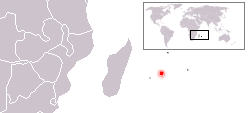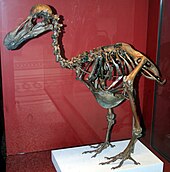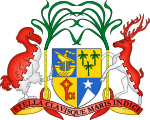Thành viên:Unpear/Dodo
| Dodo | |
|---|---|
| Thời điểm hóa thạch: Hậu Holocen | |
 Hình ảnh dựng lại Dodo theo nghiên cứu mới tại Bảo tàng Lịch sử Tự nhiên của Đại học Oxford | |
| Tình trạng bảo tồn | |
| Phân loại khoa học | |
| Giới (regnum) | Animalia |
| Ngành (phylum) | Chordata |
| Lớp (class) | Aves |
| Bộ (ordo) | Columbiformes |
| Họ (familia) | Columbidae |
| Phân họ (subfamilia) | †Raphinae |
| Chi (genus) | †Raphus Brisson, 1760 |
| Loài (species) | †R. cucullatus |
| Danh pháp hai phần | |
| †Raphus cucullatus (Linnaeus, 1758) | |
 Hạng cũ (đỏ) | |
| Danh pháp đồng nghĩa | |
| |
Dodo (Raphus cucullatus) là một loài chim không biết bay đặc hữu của đảo Mauritius ở Ấn Độ Dương. Có họ hàng với họ Bồ câu, chúng cao 1 m (3 bộ), nặng khoảng 20 kilôgam (44 lb), ăn trái cây và làm tổ dưới mặt đất.
Loài dodo đã tuyệt chủng từ nửa cuối thế kỉ 17.[1] Chúng thường được xem là biểu tượng của sự tuyệt chủng của các loài sinh vật vì sự tuyệt chủng được ghi nhận trong lịch sử loài người và bị ảnh hưởng trực tiếp vì các hoạt động của họ.
Khám phá và tên gọi
[sửa | sửa mã nguồn]
Các mô tả đầu tiên về loài chim này được thực hiện bởi người Hà Lan. Họ gọi loài chim Mauritius này là walghvogel ("chim tắm bùn" hay "chim khó ưa") dựa trên mùi vị của chúng. Dù nhiều ghi chép sau đó cũng cho rằng thịt mùi vị rất tê, cái nhật kí hành trình đầu tiên nói thịt chúng dai nhưng ngon.[2] Tên walgvogel được dùng lần đầu bởi nhật ký của phó đô đốc Wybrand van Warwijck khi đến thăm đảo năm 1598 và đặt tên đảo này Mauritius.
Nguồn gốc của tên dodo không rõ ràng. Một số cho rằng nó bắt nguồn từ từ Hà Lan dodoor nghĩa là "kẻ lười biếng", nhưng có nhiều khả năng liên quan đến từ dodaars ("mông-bướu"), dựa tên cái bướu ở phần cuối của chúng. Ghi nhận đầu tiên về từ dodaerse nằm trong nhật kí của thuyền trưởng Willem van Westsanen năm 1602.[3] Thomas Herbert dùng từ dodo năm 1627[4], nhưng không rõ ràng dù ông dùng nó đầu tiên; người Bồ Đào Nha đã đến đảo này năm 1507, nhưng họ đã không đề cập đến loài chim này. Tuy nhiên, theo từ điển Encarta và từ điển Chambers, "dodo" xuất phát từ từ Bồ Đào Nha doudo (hiện nay là doido) nghĩa là "ngốc" hay "điên".[5][6] Tuy nhiên, tên loài chim này trong tiếng Bồ Đào Nha hiện đại là dodô, bắt nguồn từ cách gọi quốc tế của loài.
David Quammen đã xem xét ý tưởng rằng từ dodo là một từ tượng thanh dựa trên tiếng kêu của chúng.[7]
Năm 1606 Cornelis Matelief de Jonge đã viết một mô tả quan trọng về loài dodo, cùng một số loài chim, động vật và thực vật trên đảo.[8]
Phân loại và tiến hoá
[sửa | sửa mã nguồn]
Dodo có họ hàng gần với các loài bồ câu hiện đại. Phân tích trình tự mtADN cytochrome b và 12S rARN[9] chỉ ra rằng tổ tiên loài dodo đã tách ra từ các họ hàng rất gần được biến đến của chúng, Rodrigues Solitaire (hiện cũng đã tuyệt chủng), vào khoảng giữa ranh giới của kỷ Paleogen và kỷ Neogen.[10] Mascarenes có nguồn từ núi lửa và ít hơn 10 triệu năm tuổi, tổ tiển của cả hai loài chim nhiều khả năng vẫn còn có thể bay sau khi tách khỏi dòng dõi của chúng. Các nghiên cứ tương tự chỉ ra rằng loài Bồ câu Nicobar Đông Nam Á là loài còn sống có họ hàng gần nhất với dodo và Réunion Solitaire.[11]
Tuy nhiên, các đề xuất phát sinh loài đặt nghi vấn nhiều hơn về mối quan hệ với đơn vị phân loài khác[12] và do đó giả thuyết được xem xét phải chờ các nghiên cứ sâu xa. Những gì có thể chắc chắn hiện nay là tổ tiên của loài chim đã tuyệt chủng là những con bồ câu Đông Nam Á hay Wallacea, trùng khớp với nguồn gốc của nhiều loài chim Mascarenes.
Trong một thời gian dài, dodo và Rodrigues Solitaire (được gọi chung là "didines") được xếp vào họ của riêng chúng, họ Raphidae. Bởi vì quan hệ giữa nhóm chim này với các loài chim khác vẫn chưa được làm sáng tỏ. Đến gần đây, xuất hiện nhiều lý do để xếp nhóm didines vào phân họ Raphinae thuộc họ Bồ câu.
Hình thái học và việc không biết bay
[sửa | sửa mã nguồn]
Tháng 10, 2005, một phần của Mare aux Songes, địa điểm quan trọng về những gì còn lại của loài dodo, đã được khai quật bởi một đội nghiên cứu quốc tế. Nhiều thứ được tìm thấy, bao gồm xương của nhiều giai đoạn trưởng thành của loài chim này,[13] and several bones obviously belonging to the skeleton of one individual bird and preserved in natural position.[5] These findings were made public in tháng 12 2005 in the Naturalis in Leiden. Before this, few associated dodo specimens were known, hầu hết the material consisting of isolated and scattered bones. Dublin's Natural History Museum and the Oxford University Museum of Natural History, among others, have a specimen assembled from these disassociated remains. A Dodo egg is on display at the East London museum in Nam Phi.


Until recently, the most intact remains, currently on display at the Oxford University Museum of Natural History, were one individual's partly skeletal foot and head which contain the only known soft tissue remains of the species. Manchester Museum has a small collection of Dodo bones on display.
The remains of the last known stuffed dodo had been kept in Oxford's Ashmolean Museum, but in the mid-18th century, the specimen – save the pieces remaining now – had entirely decayed and was ordered to be discarded by the museum's curator or director in or around 1755.
In tháng 6 2007, adventurers exploring a cave in Mauritius discovered the most complete and well-preserved dodo skeleton ever.[14]
According to artists' renditions, the Dodo had greyish plumage, a 23-centimeter (9-inch) bill with a hooked point, very small wings, stout yellow legs, and a tuft of curly feathers high on its rear end. Dodos were very large birds, weighing about 23 kg (50 pounds). The sternum was insufficient to support flight; these ground-bound birds evolved to take advantage of an island ecosystem with no predators.
The traditional image of the dodo is of a fat, clumsy bird, hence the synonym Didus ineptus, but this view has been challenged in recent times. The general opinion of scientists today is that the old drawings showed overfed captive specimens.[15] As Mauritius has marked dry and wet seasons, the dodo probably fattened itself on ripe fruits at the end of the wet season to live through the dry season when food was scarce; contemporary reports speak of the birds' "greedy" appetite. In captivity, with food readily available, the birds became overfed very easily.
Diet
[sửa | sửa mã nguồn]The tambalacoque, also known as the "dodo tree", was hypothesized by Stanley Temple to have been eaten from by Dodos, and only by passing through the digestive tract of the dodo could the seeds germinate; he claimed that the tambalacocque was now nearly extinct due to the dodo's disappearance. He force-fed seventeen tambalacoque fruits to Wild Thổ Nhĩ Kỳs and three germinated. Temple did not try to germinate any seeds from control fruits not fed to turkeys so the effect of feeding fruits to turkeys was unclear. Temple also overlooked reports on tambalacoque seed germination by A. W. Hill năm 1941 and H. C. King năm 1946, who found the seeds germinated, albeit very rarely, without abrading.[16][17][18][19]
Extinction
[sửa | sửa mã nguồn]
As with many animals that have evolved in isolation from significant predators, the dodo was entirely fearless of people, and this, in combination with its flightlessness, made it easy prey for humans.[20] However, journals are full of reports regarding the bad taste and tough meat of the dodo, while other local species such as the Red Rail were praised for their taste. When humans first arrived on Mauritius, they also brought with them other animals that had not existed on the island before, bao gồm dogs, pigs, cats, rats, and Crab-eating Macaques, which plundered the dodo nests, while humans destroyed the forests where the birds made their homes;[21] currently, the impact these animals—especially the pigs and macaques—had on the dodo population is considered to have been more severe than that of hunting. The 2005 expedition's finds are apparently of animals killed by a flash flood; such mass mortalities would have further jeopardized a species already in danger of becoming extinct.[22]

Although there are scattered reports of mass killings of dodos for provisioning of ships, archaeological investigations have hitherto found scant evidence of human predation on these birds. Some bones of at least two dodos were được tìm thấy ở caves at Baie du Cap which were used as shelters by fugitive slaves and convicts in the 17th century, but due to their isolation in high, broken terrain, were not easily accessible to dodos naturally.[23]
There is some controversy surrounding the extinction date of the dodo. Roberts & Solow state that "the extinction of the Dodo is commonly dated to the last confirmed sighting in 1662, reported by shipwrecked mariner Volkert Evertsz" (Evertszoon), but many other sources suggest the more conjectural date of 1681. Roberts & Solow point out that because the sighting prior to 1662 was in 1638, the dodo was likely already very rare by the 1660s, and thus a disputed report from 1674 cannot be dismissed out-of-hand.[24] Statistical analysis of the hunting records of Isaac Johannes Lamotius give a new estimated extinction date of 1693, with a 95% confidence interval of 1688 to 1715. Considering more circumstantial evidence such as travelers' reports and the lack of good reports after 1689,[23] it is likely that the dodo became extinct before 1700; the last Dodo died a little more than a century after the species' discovery in 1581.[25]
Few took particular notice of the extinct bird. By the early 19th century it seemed altogether too strange a creature, and was believed by many to be a myth. With the discovery of the first batch of dodo bones in the Mauritian swamp, the Mare aux Songes, and the reports written about them by George Clarke, government schoolmaster at Mahébourg, from 1865 on,[26] interest in the bird was rekindled. In the same year in which Clarke started to publish his reports, the newly vindicated bird was featured as a character in Lewis Carroll's Alice's Adventures in Wonderland. With the popularity of the book, the dodo became a well-known and easily recognizable icon of extinction.[27]

Cultural significance
[sửa | sửa mã nguồn]The dodo is used by many environmental organizations that promote the protection of endangered species, such as the Durrell Wildlife Conservation Trust and the Jersey Zoological Park, founded by Gerald Durrell.[28]
The dodo's significance as one of the best-known extinct animals and its singular appearance has led to its use in literature and popular culture to symbolize a concept or object that will or has become out of date, as in the expression "dead as a dodo" or "gone the way of the dodo".[29][30]
The dodo rampant appears on the coat of arms of Mauritius.[21]
Xem thêm
[sửa | sửa mã nguồn]- Dodo (Alice's Adventures in Wonderland)
- Island gigantism
- List of extinct birds
- Extinct (2001 TV series)
- Porky in Wackyland (1938)
Tham khảo
[sửa | sửa mã nguồn]- ^ BirdLife International (2004). Raphus cucullatus. Sách đỏ 2006. IUCN 2006. Truy cập 2006-12-07. Database entry includes justification for why this species is listed as extinct.
- ^ A trve report of the gainefull, prosperous, and speedy voiage to Iava in the East Indies, performed by a fleete of eight ships of Amsterdam: which set forth from Texell in Holland, the first of Maie 1598. Stilo Novo. Whereof foure returned againe the 19. of Iuly Anno 1599. in lesse thaen 15 moneths: the other foure went forward from Iava for the Moluccas
- ^ Staub, France (1996): Dodo and solitaires, myths and reality. Proceedings of the Royal Society of Arts & Sciences of Mauritius 6: 89-122 HTML fulltext
- ^ Strickland, H.E. (1848) The Dodo and its Kindred London: Reeve, Benham and Reeve. p.128
- ^ a b “Dodo skeleton find in Mauritius”. BBC News. London. 24 tháng 6 năm 2006. Truy cập ngày 28 tháng 8 năm 2006.
- ^ The Portuguese word doudo or doido may itself be a loanword from Old English (cf. English "dolt").
- ^ Quammen, David (1996): The Song of the Dodo: Island Biogeography in an Age of Extinction. Touchstone, New York. ISBN 0684827123
- ^ Staub, France. “Le musée du Dodo”. Potomitan. Truy cập ngày 18 tháng 1 năm 2009.
- ^ Shapiro, Beth; Sibthorpe, Dean; Rambaut, Andrew; Austin, Jeremy; Wragg, Graham M.; Bininda-Emonds, Olaf R. P.; Lee, Patricia L. M. & Cooper, Alan (2002): Flight of the Dodo. Science 295: 1683. doi:10.1126/science.295.5560.1683 (HTML abstract) Supplementary information
- ^ See Raphidae as for why the date "25 mya" is suspect
- ^ “DNA yields dodo family secrets”. BBC News. London. 28 tháng 2 năm 2002. Truy cập ngày 7 tháng 9 năm 2006.
- ^ Johnson, Kevin P. and Dale H. Clayton (2000): Nuclear and Mitochondrial Genes Contain Similar Phylogenetic. Signal for Pigeons and Doves (Aves: Columbiformes). Molecular Phylogenetics and Evolution 14(1): 141–151. PDF fulltext
- ^ “Scientists find 'mass dodo grave'”. BBC News. London. 24 tháng 12 năm 2005. Truy cập ngày 7 tháng 9 năm 2006.
- ^ “Dodo Skeleton Found on Island, tháng 5 Yield Extinct Bird's DNA”. National Geographic. 3 tháng 7 năm 2007. Truy cập ngày 9 tháng 7 năm 2007.
- ^ Kitchener, A. On the external appearance of the dodo, Raphus cucullatus. Archives of natural History, 20, 1993.
- ^ Temple, Stanley A. (1977): Plant-animal mutualism: coevolution with Dodo leads to near extinction of plant. Science 197(4306): 885-886. HTML abstract
- ^ Hill, A. W. (1941): The genus Calvaria, with an account of the stony endocarp and germination of the seed, and description of the new species. Annals of Botany 5(4): 587-606. PDF fulltext (requires user account)
- ^ King, H. C. (1946). Interim Report on Indigenous Species in Mauritius. Government Printer, Port Louis, Mauritius.
- ^ Witmer, M. C. & Cheke, A. S. (1991): The dodo and the tambalacoque tree: an obligate mutualism reconsidered. Oikos 61(1): 133-137. HTML abstract
- ^ “Scientists pinpoint dodo's demise”. BBC News. London. 20 tháng 11 năm 2003. Truy cập ngày 7 tháng 9 năm 2006.
- ^ a b Jonathan Fryer (14 tháng 9 năm 2002). “Bringing the dodo back to life”. BBC News. London. Truy cập ngày 7 tháng 9 năm 2006.
- ^ Tim Cocks (4 tháng 6 năm 2006). “Natural disaster may have killed dodos”. Reuters. Truy cập ngày 30 tháng 8 năm 2006.
- ^ a b Janoo, Anwar (2005): Discovery of isolated dodo bones [Raphus cucullatus (L.), Aves, Columbiformes] from Mauritius cave shelters highlights human predation, with a comment on the status trong họ Raphidae Wetmore, 1930. Annales de Paléontologie 91: 167–180. [English with French abstract] DOI:10.1016/j.annpal.2004.12.002 (HTML abstract) Hume et al. ref probably too.
- ^ Roberts, David L. & Solow, Andrew R. (2003): Flightless birds: When did the dodo become extinct? Nature 425(6964): 245. doi:10.1038/426245a (HTML abstract)
- ^ Dodo Bird FAQs - WikiFAQ - Answers to Frequently Asked Questions (FAQ)
- ^ Lewis Carroll's Alice's Adventures in Wonderland was published năm 1865.
- ^ Mayell, Hillary (28 tháng 2 năm 2002). “Extinct Dodo Related to Pigeons, DNA Shows”. National Geographic News. Truy cập ngày 19 tháng 1 năm 2009.
- ^ Dee pa Unhook (26 tháng 9 năm 2006). “Mauritius: Footprints From the Past”. expresser's. Truy cập ngày 26 tháng 9 năm 2006. (requires subscription)
- ^ Steve Miller (25 tháng 9 năm 2006). “First The Dodo, Now Full-Size SUV”. Brand Week. Truy cập ngày 26 tháng 9 năm 2006.
- ^ “Water ford Wildlife”. Water ford Today. 1 tháng 1 năm 2006. Truy cập ngày 26 tháng 9 năm 2006.
Liên kết ngoài
[sửa | sửa mã nguồn]- The Oxford Dodo Retrieved 2009-02-08
- The Extinction Website: Species Info - Raphus cucullatus. Retrieved 2006-12-07.
- Rajith Dissanayake: What did the dodo look like?. Retrieved 2008-05-04.
- Uncovered: 350-year-old Picture of Dodo Before it was Extinct by The Telegraph
- H.E. Strickland's The Dodo and its Kindred (London: 1848) - full digital facsimile, Linda Hall Library

